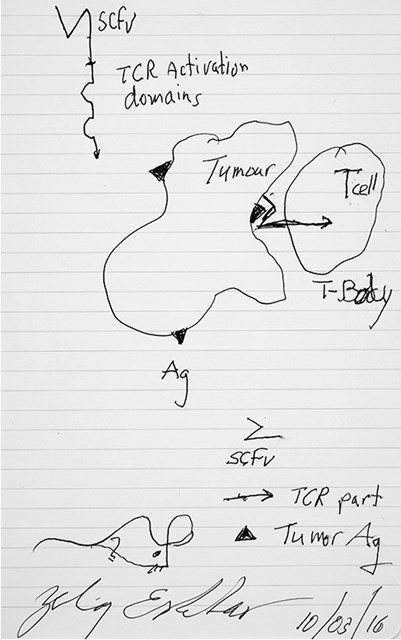The world’s great cancer immunologists sketch their research

“Still life: mouse with T-body.” A work by Zelig Eshhar, scientist and cartoonist. From A Cure Within: Scientists Unleashing the Immune System to Kill Cancer, Neil Canavan
The Weizmann Institute is rightly proud of its scientists’ creativity. It is actively encouraged, and has led to many important advances and partnerships (research projects and jazz combos alike). And recently, our Prof. Zelig Eshhar inspired other immunologists with a sketch on a bit of paper.
It’s a familiar trope: the scribble on the napkin, the back-of-the-envelope calculation that ignites the big idea. In this case, Eshhar’s sketch set off a chain reaction, resulting in a clever book that clearly explains one of today’s most transformative scientific revolutions.
In the science world, Eshhar is a rock star. In the 80s, he came up with the chimeric antigen receptor (CAR) T-cell technique, a form of cancer immunotherapy that today is saving lives. In fact, it has been close to 95% effective in producing full remission in a severe, often fatal form of leukemia – an absolutely stunning success. Other scientists across the globe are now working with CAR-T (which was FDA approved last year), advancing and targeting it to other cancers.
In 2016, Eshhar was at an immunotherapy conference when he was approached by science communicator and journalist Neil Canavan. In an article in STAT, Canavan tells us that he had just begun a new job and needed to better understand cancer immunotherapy so that he could, in turn, explain it to his new colleagues.
About his conversation with Eshhar, Canavan writes: “As we talked, he exclaimed, ‘Oh – this is not so complicated,’ then grabbed my notebook and drew a little diagram to explain this technology. With a wink he said, ‘You should frame this – I am famous.’ So I did, and set it on my desk at work.”
That was the first domino.
Next, Canavan explains, another world-leading immunologist – Dr. Drew Pardoll of Johns Hopkins – was visiting his office. Pardoll “saw Eshhar’s cartoon on my desk and said, ‘Wow — that guy’s really famous.’” (Apparently Eshhar is right about many things.) Canavan asked if Drew would also like to draw a cancer immunotherapy cartoon. He would, and did, and it, too, was framed and placed on Canavan’s desk.
The dominos kept falling, and two years later, the clearly incredibly well-connected Canavan’s office was overflowing with cancer immunotherapy cartoons by leading researchers.
Now they can be yours, too: Canavan collected them, around 50 in all, alongside interviews with their creators, in A Cure Within: Scientists Unleashing the Immune System to Kill Cancer (2018, Cold Spring Harbor Laboratory Press).
Science communication is tricky. Years ago, a scientist – and superb explainer – shared with me the scicomm maxim: you can be clear or you can be correct, but you can’t be both. Drawings, however, can offer a way around that conundrum. I hate to say this but it’s so apropos that it must happen: a picture is worth a thousand words.
After all, it took Eshhar decades to get his CAR-T method out into the world, but was able to explain, in seconds, this “not so complicated” (to him, maybe) technology on a scrap of paper.
The drawings tell you as much about the scientist as the science they are illustrating – there are many (many) examples of wonkiness, of charmingly dorky senses of humor, of varying degrees of successful hand-eye coordination … each tells a personal story, even as it explains a concept.
One of my favorites is by Dr. Philip Greenberg, head of immunology at Fred Hutchinson Cancer Research Center (which has performed amazing research using Eshhar’s CAR-T technique): not that we’re going to psychoanalyze Dr. Greenberg, but his T-cells are marvels of complexity, fully realized, containing even the Grateful Dead’s Steal Your Face lightning-bolt skull – yet his people are primitive stick figures.
By contrast, the person in Replimune CEO Dr. Robert Coffin’s drawing looks (unintentionally, I’m sure) like a voodoo doll, covered in prickly spots and complete with a needle sticking in its thigh.
A Cure Within is not just about cancer immunotherapy, but the lives and minds of those who envisioned it and brought it to life. The cartoons make it clear that, contrary to the ascetic image many people have of scientists, these brilliant researchers are so very funny and warm and human. Eshhar, for example, is a man of many interests and passions – he was even a master beekeeper – and has spoken about the roles of intuition, of serendipity, of feeling and emotion, in science. He makes for a fine artist.


